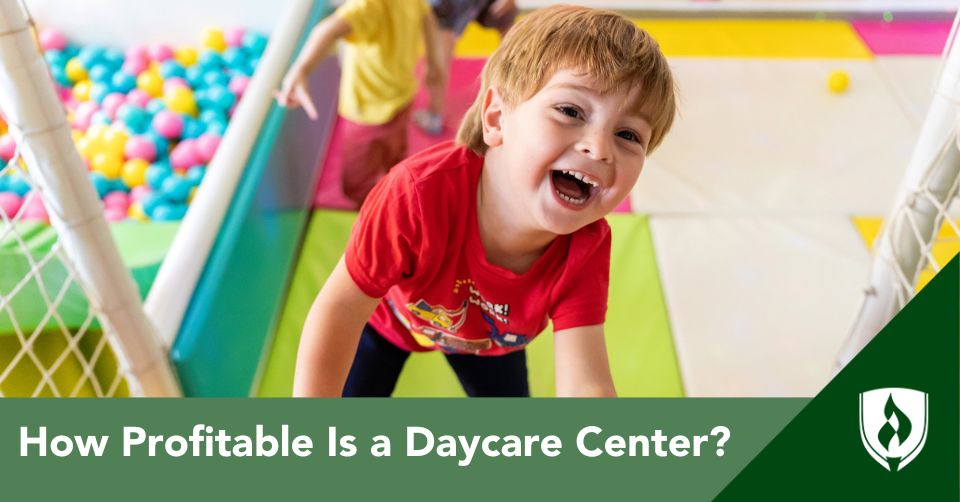
If you've ever had children in childcare, you know this essential service does not come cheap. Many families pay the equivalent of a month's rent or more in childcare costs—and it's easy to wonder...are daycare centers making bank?1
You might well wonder about offering childcare yourself! If you love working with children, opening a daycare business can feel like the perfect career move. It combines the chance to make a difference in young lives with the possibility of running a profitable venture. And if you have your own young children, you might reason that the money you'd save by being able to take care of them yourself could add up to—a lot.
But despite the sticker price of a safe, nurturing environment for your kiddos—a financially stable childcare business takes real work to build. Owners need to understand the costs, revenue potential, and business strategies that make childcare services thrive.
The financial aspects of running a daycare center are complicated, from start-up costs and operating expenses to tuition fees, revenue streams, and long-term profitability.
But there's definitely a huge need for childcare services, and it's very worth doing for the right kind of person.
Note: While we use the terms "daycare" and "childcare" interchangeably, most early childhood education (ECE) providers prefer the term "childcare." These professionals are not caring for "days" after all, but for children. The term also helps people understand that childcare isn't just about stashing kids somewhere safe for the day, but also about offering education during all those hours where their busy, developing minds need it most.
Understanding the childcare industry
The childcare industry plays a vital role in supporting working parents and local businesses. With more families relying on two incomes, the demand for reliable childcare services continues to grow. This steady need makes daycare centers an important part of the economy and a potentially rewarding business opportunity.
There are several types of child care businesses, each with unique benefits and challenges.
Center-based childcare
These often serve more children and may generate higher monthly income, but they also come with larger operating costs like staff salaries, licensing fees and rent or mortgage payments. A childcare center might be part of a larger chain of centers and have many different campuses, or it might be just one facility zoned as a business.
Home-based childcare: A family daycare option
Home-based childcare services are usually offered in the provider's own home. These businesses save money on the cost of renting a facility, but also likely involve a smaller number of enrolled children.
A family daycare business must still apply for licensure with the state they are located in and follow the safety guidelines. Check out Should I Start a Family Day Care in My Home? Consider This First for more on what they need.2
Home based childcare businesses typically have lower overhead costs and a smaller number of children enrolled, which can make them easier to manage while still providing quality care.
Understanding these options in the daycare industry can help prospective daycare owners choose the business model that aligns with their goals and resources.
Key factors that influence profitability
Several factors determine how profitable a daycare business can be. Understanding these factors early will help daycare owners plan for success and avoid unexpected costs.
How location and market competition affect childcare profitability
Where your childcare center is located has a big impact on its success. A daycare facility in a busy area with many working parents may fill up quickly, while one in a small community with fewer families could struggle to attract children. Local businesses and schools nearby can also affect demand.
The term "childcare deserts" has been part of the industry for quite a while now. It represents the areas of a geographical range that have few or no childcare providers for the families nearby. Living in a childcare desert can be extremely difficult for families, with parents needing to commute long distances, hire someone to live with them or come up with other solutions to find child care.
Depending on income levels of the families in these areas, positioning your business where the demand is highest (and where existing supply is low) can give you a strong start.
Check out this map of childcare deserts to see which areas by you are most in-need of childcare services.4
Number of children enrolled and age group
Enrollment drives revenue. The more children enrolled, the higher the potential monthly income.
Age groups matter too, since infants often require a lower staff-to-child ratio than older children, which can increase staff salaries and operating costs.3
Staffing is the biggest driver of profitability, according to Rasmussen University ECE instructor, Barbara Wagner.
“It is important to get a clear understanding of how many children of each age group need to be enrolled to cover costs,” Wagner explains. She also cautions that discounts or perks—like part-time care, vacation weeks or other additional services—may impact the bottom line.
"You are still paying staff a full-time rate in most cases,” she explains.
Licensing requirements and fees
Daycare centers must meet licensing standards that vary by state. These can include safety inspections, staff-to-child ratios and background checks for employees. Licensing fees and compliance costs are part of your operating costs and should be included in your financial projections.
Comparing daycare facility sizes: Home-Based vs. mid-Sized vs. large Centers
A home-based daycare usually has lower overhead costs, such as reduced rent or mortgage payments, but it can only serve a limited number of children.
A mid-sized daycare center might balance capacity with manageable operational costs, while a large daycare center can generate more tuition fees but also requires higher staff salaries, larger facility costs and more complex daily operations.
But your monthly expenses go beyond salaries and rent.
“Childcare centers need to budget for food, utilities, insurance, memberships, training, advertising and curriculum materials," Wagner says. Many childcare businesses also have ‘specials’ like on-site soccer or music lessons, she adds.
For home-based providers, many expenses overlap but they may also benefit from tax deductions on mortgage and utilities.
Major startup costs for a daycare business
Starting a daycare business requires careful planning and enough funding to cover upfront expenses. These costs can vary depending on whether you open a home-based daycare or a larger childcare center, but most daycare owners should expect these common startup costs.5
Wagner emphasizes that one of the biggest challenges is unexpected costs.
“I have seen individuals pour their savings into purchasing a building, only to find out licensing needs architectural drawings of the space—or that they must make costly upgrades to meet licensing standards or city codes,” Wagner explains.
She also notes that staffing can be a barrier. “In rural areas, many centers struggle, not because they can’t find families to fill their program, but because they can’t find teachers to fill the classrooms.”
Licensing, insurance and legal setup
Every childcare center must meet state licensing requirements. This often involves application fees, safety inspections and background checks. You’ll also need liability insurance to protect your business and legal support for setting up your business structure.
Facility expenses for daycare centers
Whether you choose rent or mortgage payments, facility costs are one of the biggest expenses. A home-based daycare often has lower overhead costs, while a mid-sized or large daycare center needs more space, which increases rent, utilities and maintenance expenses.
Educational materials and equipment
High quality care requires age-appropriate educational materials and safe equipment. This can include toys, books, learning supplies, cribs, nap mats, and outdoor play structures. These purchases not only support early childhood education but also improve the customer experience for families.
Initial marketing efforts
Even the best daycare services need to reach families. Marketing strategies like online advertising, word of mouth referrals and printed flyers help build awareness and attract your first group of children enrolled.
“Location can be an issue,” Wagner says. “A program that is tucked away may not get much visibility, so it’s vital to advertise and maintain an online presence.”
Wagner recalls a center that boosted enrollment through community events and parades. She also emphasizes the role of referrals and state systems. “Word-of-mouth is powerful, and in some states, QRIS ratings even provide free advertising to programs on official websites.”
Estimating monthly income
One of the biggest questions new daycare owners have is how much they can realistically earn each month. The answer depends on tuition rates and how many children your daycare can legally and safely accommodate.
Most childcare centers in the U.S. charge between $700 and $1,000 per child each month.7 The number of children you can enroll depends on state licensing rules, with set staff‑to‑child ratios for safety.
For example, many states require one staff member for every four infants, one for every six toddlers and larger ratios for preschool and school‑age children. These guidelines ensure quality care but also determine how many children your facility can serve.
To give a sense of scale:
- A home‑based daycare serving 8–12 children could bring in $6,400 to $9,600 a month.
- A mid‑sized daycare center with 30 children at $800 per child could reach around $24,000 a month.
- A larger center with 50 children might earn closer to $40,000 a month.
These examples show gross income before expenses, however.
Profit margins in the daycare business
Of course, tuition income is only one side of the equation. To understand how profitable a daycare really is, you need to look at profit margins—the money left after monthly expenses.
Typical expenses include staff salaries, rent or mortgage payments, utilities, food, insurance and educational materials. You should also retain a certain amount of money each year for costs related to maintaining your childcare license, taxes, software for any business-related needs, etc...
After paying these, most daycare centers see a net profit margin of about 5–10 percent.6
Home‑based programs often keep more of their revenue because they have lower overhead costs. On the other hand, larger centers can generate more income overall but need to balance higher staff and facility costs. Managing cash flow—like keeping up with payroll and handling seasonal enrollment changes—is also key to staying financially stable.
Home-based daycare vs center-based daycare
When choosing between starting a home‑based or center‑based daycare, the decision often comes down to how quickly you want to grow and how much you're able to invest upfront.
Home‑based daycares usually have modest startup costs— typically $5,000 to $10,000—covering licensing, safety gear, toys and furniture.4
That makes them attractive to new providers. But they’re limited in scale by licensing rules, often serving just a handful of kids.
In contrast, setting up a center-based daycare requires significantly more capital. A small to mid-size facility may cost $11,000 to $22,000 to start, while larger centers—with renovations and full equipment—often need $30,000 to $50,000 or more.5,4
Financial planning for long-term success
A daycare business is about more than caring for children—it’s also about running a stable, sustainable operation. That’s why financial planning plays such a big role in long‑term success.
Creating a detailed business plan is the first step. A solid plan outlines your goals, expected enrollment, tuition rates, and projected expenses like staff salaries, licensing fees and facility costs. It also helps you anticipate challenges, from seasonal enrollment dips to higher supply costs, so you’re not caught off guard.
Financial projections and regular tracking make it easier to see whether your daycare is on course. Many daycare owners use spreadsheets or childcare‑specific software to monitor monthly earnings and operating costs. This kind of ongoing tracking can highlight problems early, like rising food expenses or unexpected repairs, so you can make adjustments before they affect your bottom line.
If you need startup funding, a well‑prepared business plan also strengthens your case with lenders or investors. Showing that you’ve thought through tuition fees, local market demand, and cash flow demonstrates you’re serious about running a financially sound childcare center.
The more intentional you are about planning, the more financial stability you can create for your center.
“Many programs could avoid potential closures by having an accurate understanding of initial costs and what it will take to open a program,” Wagner says. She recommends planning for partial enrollment at the start, noting that projections should “be based on a smaller scale since you may not be able to open with full capacity right away.”
Is running a daycare center a profitable business?
Starting a daycare business can be both rewarding and financially sustainable, but most daycare owners don’t see big profits right away. For many providers, it takes several months—or even the first year—to cover startup costs and steady their monthly earnings.
The financial return often depends on how quickly you can enroll enough children to cover operating costs like staff salaries, rent or mortgage payments and educational materials. A detailed business plan and strong cash flow management can help you reach profitability sooner.
Wagner encourages new providers to look for support systems. “Many ‘Child Care Resource and Referral’ agencies offer start-up grants, while organizations like First Children’s Finance provide low-interest loans and business support,” she explains. “Some state economic development departments even earmark funds to support new programs.”
Of course, profitability isn’t just about numbers. Many daycare owners point to the personal fulfillment that comes from supporting children and families in their community. When combined with sound financial planning, that passion can be the foundation for long-term success.
Signs that your daycare is on the right path include steady enrollment, positive word of mouth referrals and a healthy balance between tuition fees and operating costs. If your childcare center is consistently attracting more families, keeping expenses manageable, and maintaining high-quality care, you’re more likely to build a profitable and sustainable business.
Understanding the complexity of childcare
Childcare is unlike any other industry. There are many regulations, laws and licensing requirements particular to childcare to go along with the important elements of starting a business.
The childcare business owners who thrive tend to be professionals who have truly done their homework, researched their areas, planned a solid budget and learned how to navigate the complex waters of early childhood education and services.
Some might decide to earn a credential like the CDA® (Child Development Associate®) to learn about child development and show prospective families and customers that their children are in safe, educated hands.
Others might choose to earn a Business certificate to understand the basics of starting and maintaining a business.
Either way, opening a daycare center means doing your research! Check out Why Is Childcare So Expensive? 7 Factors at Play to go a little deeper into the costs and benefits of this industry.
So, how profitable is a daycare center? It depends on you.
1This blog is for general informational purposes only and does not constitute advice.
2(2023, July 6). Should I start a family day care in my home? Consider this first. Rasmussen University. https://www.rasmussen.edu/degrees/education/blog/should-i-start-a-family-day-care-in-my-home
3Office of the Inspector General — Licensing Division. Ratio and group size standards for licensed child care [PDF]. Minnesota Department of Human Services. https://mn.gov/dhs/assets/ratio-and-group-size-standards-for-licensed-child-care_tcm1053-340437.pdf
4U.S. Child Care Deserts. (n.d.). Child care deserts. https://childcaredeserts.org/
5(2025, January 3). 7 daycare center expenses: Budgeting for a daycare business. Procare Solutions. https://www.procaresoftware.com/blog/7-daycare-center-expenses-how-much-does-it-cost-to-start-your-own-daycare-business/
6(2025, June 16). What is the profit margin of a daycare? https://dojobusiness.com/blogs/news/daycare-profit-margin
7(2025, September 9). Childcare costs in the USA 2025: A state‑by‑state overview. Illumine. https://illumine.app/blog/how-much-childcare-costs-by-state-in-usa
8CDA® is a registered trademark of Council for Professional Recognition




